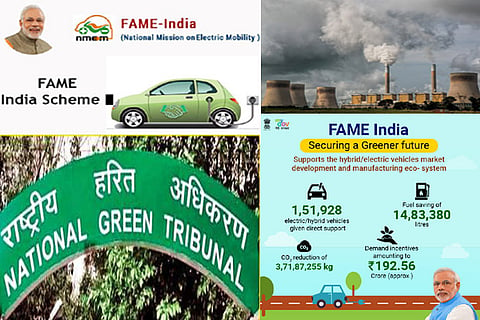

Chennai
His comments have reignited a discourse regarding India’s move towards EV adoption. And arguments for making this shift are increasing. A recent report said India continues to be the top global emitter of Sulfur Dioxide (SO2), an air pollutant that increases the risk of heart disease and lung cancer. The nation emitted 21% of the global anthropogenic (human made) SO2 emissions, twice as much as Russia’s emissions.
Experts have been crying hoarse that India needs to make a conscious shift towards renewable energy sources and EVs. The Centre had envisioned a 30 per cent EV penetration in the transport sector by the year 2030 and is counting on the Faster Adoption and Manufacturing of Hybrid & Electric Vehicles Policy (FAME Policy). However, the mass adoption of any such new technology involves the creation of supportive infrastructure, in this case, battery manufacturing, and storage, as well as the setting up of charging point networks, as well as boosting the local manufacturing which can make the vehicles more affordable.
Several challenges are ailing the EV sector presently. As per a 2018 report, India had just about 650 charging stations, which is grossly inadequate for India’s size. China by that time had over 4,56,000 charging stations. Moreover, the average on-road price of EVs (over Rs 10 lakh for four-wheelers) in India is not a top draw for consumers who are constantly worried about mileage. Another point of concern is auto majors being caught between cutting costs of EVs while simultaneously pumping in crores to boost the private EV infrastructure. The industry is also lagging as EVs make up for less than 1% of total vehicle sales in India.
The FAME policy mandates that manufacturing companies will be eligible for subsidies only if at least 50 pc of the components are sourced locally, indeed a challenge owing to the low percentage of component makers here. Niti Aayog CEO Amitabh Kant had remarked that the government has lowered the tax rate on EVs to 5 per cent as compared to the 28 per cent tax on other vehicles and 43 per cent for hybrid vehicles. Pinning his hopes on an 80 pc adoption by citizens, Kant highlighted the tax exemption of up to Rs 1 lakh given to people buying EVs.
Tamil Nadu has also stepped on the accelerator as it had informed the National Green Tribunal last month that it will set up charging stations on national and state highways in a few districts including Chennai, Coimbatore, and Tiruchy. Plans are afoot to set up charging points in government offices too. For consumers, there is a 100 pc motor vehicle tax exemption on EVs till 2022. Companies involved in making EVs and charging infrastructure will be offered 100 pc exemption on electricity tax till Dec 2025.
Presently, Phase II of the FAME scheme is being implemented for three years from April 2019 and has a budgetary support of Rs 10,000 crore. As many as 241 charging stations have been planned in states including TN, Kerala and Gujarat as part of the scheme. Through subsidies, about 7,000 e-Buses, five lakh e-3 wheelers, 55,000 e-4 wheeler passenger cars, and 10 lakh e-2 wheelers will be supported in this phase. Adequate support from state governments can act as further incentives for manufacturers, consumers, and ancillary industries to go green. In the aftermath of the pandemic, our focus must be concentrated on long-term sustainability as opposed to short-term profits.
Visit news.dtnext.in to explore our interactive epaper!
Download the DT Next app for more exciting features!
Click here for iOS
Click here for Android